Nine Innings: How Bryce Harper Is Trying to Revive His Season, What We Learned in the First Half and More

HOW BRYCE HARPER IS TRYING TO TURN HIS SEASON (AND THE NATIONALS') AROUND
By Tom Verducci
The worst slump in the career of Washington Nationals outfielder Bryce Harper might have turned at 2:30 in the afternoon Saturday with the same manner in which little kids are introduced to baseball: hitting off a batting tee. The second half of the Nationals’ season—and perhaps as much as $400 million—may be riding on that emergency tutorial.
Since April 17, Harper had hit .189 with 79 strikeouts in 69 games. His contact rate and rollover rate (groundballs to the pull side) were the worst of his career. You could blame the pressure of impending free agency, the lack of strikes that he sees or the effect of defensive shifts—and all are in play—but the root cause of the slump was a breakdown in the complicated mechanics of his swing.
“He’s known it and he’s been working hard on it for a long time,” said Nationals hitting coach Kevin Long. “He probably needs two or three days off, but he’s Bryce. We need him.”
Harper always has hit with a violent, unorthodox swing. He always has sunk into his legs as he begins to swing, drops his head down and then pulls it back up and away on contact, flies his front hip open forcefully, and gets so firm on his front side that his back foot leaves the ground.
But here’s how his swing fell apart. It started by sinking too far into the legs upon the pitcher’s release. By bending too far down, Harper created more of an upward path with the barrel of his bat. It also caused him to jump at the baseball, forcing his front side to open too early and too far. His back foot would slide behind him. Without a stable base, Harper could do almost nothing with the pitch away:
Harper on Pitches Away
| Average | Hits | Strikeouts |
|---|---|---|---|
2018 | .153 | 11 | 23 |
2017 | .333 | 35 | 19 |
“Right now you can pitch to him,” said one manager recently. “You have places to go where you know you can get him out.”
Said Nationals manager Dave Martinez, “He’s been getting his pitches and just fouling them back. He’s told me about how frustrated he’s been because of that. Because this guy cares. He wants to win.”
He wasn’t hitting in bad luck. Harper earned every bit of that .189 average over almost three months with poor swings that resulted in either rolling over into the shift or swings and misses:
Harper Groundball Outs Into Shift
2018 | 42 |
|---|---|
2017 | 16 |
2016 | 32 |
2015 | 22 |
Harper Swings and Misses
| No. | Whiff Rate |
|---|---|---|
2018 | 236 | 33% |
2017 | 259 | 27% |
2016 | 245 | 23% |
So on Saturday Harper worked with Long and assistant hitting coach Joe Dillon on mechanical fixes to his swing. On the field, they set the tee on the inside corner of the plate and had Harper whack balls to the pull field. Then they set it on the outside corner of the plate and had him drill balls to leftfield.
The fix: hit with a more stable base from a “taller” position—much less sinking into his legs—to create a better bat path to the ball (taking the loop out of it). Why not work in the cage?
“There are always guys who want to hit in the cage,” Long said. “People are coming and going, the TV is on, there are distractions. You come out early on the field and you’re alone. You’re not rushed. No distractions.”
That night against Miami, Harper went 3-for-3 with one walk and four runs scored. His swing looked 100% better. He hit from a “taller” position with a more stable lower half. He wasn’t pulling off the ball. He wasn’t dragging his back foot. One of his hits, a single to rightfield off Wei-Yin Chen, was the first base hit all year by Harper on 40 sliders on the outside third of the strike zone.
The Nats’ season and Harper’s financial future may be riding on whether the fix is sustainable. Washington has been this season’s biggest underachiever. After the last loss in a sweep to Boston, pitcher Max Scherzer said to Martinez, “Are you okay if we have a meeting?” Replied Martinez, “Go for it.”
What Is Wrong With the Washington Nationals?
Starting pitchers don’t usually call team meetings—it should be the province of everyday players—but Scherzer is the strongest personality in an otherwise quiet room. The theme of the meeting basically was, “Guys, we’re better than this, but we better start to show it now.”
After that, all the Nationals did was stage the biggest comeback in Washington Nationals history (down 9-0, they won 14-12), win on a walkoff homer by Mark Reynolds, and win an 18-4 rout in which Reynolds joined Scooter Gennett as the only players to go 5-for-5 with 10 RBI. The Nats scored 35 in their first three games after the meeting.
Okay, the three wins came against the Miami Marlins, but with Stephen Strasburg, Ryan Zimmerman and Matt Wieters making their way back off the DL in the next two weeks, the trend arrow on Washington is pointing up.
Nobody is more important to them than Harper. His ability to carry the team through stretches is well documented. But the length and depth of his slump raised questions about the intersection of his swing, the shift and how he is pitched as he heads toward free agency.
First take a look at how Harper is facing more shifts and doing less against them:
Harper vs. Shifts:
| Percentage | BABIP |
|---|---|---|
2018 | 56% | .184 |
2017 | 22% | .281 |
2016 | 25% | .236 |
2015 | 16% | .381 |
Now consider that nobody in baseball sees more pitches out of the zone than Harper (59%). Seeing so few strikes and seeing defenses conspire against him has prompted not just a breakdown in his swing, but also a tendency to chase. And since April 17, Harper is batting .082 (7-for-82) when he chases pitches out of the zone.
Anxiety and frustration are as much enemies of a hitter as pitchers and defense. Martinez saw them creeping into Harper’s game. That’s why Martinez said it was his idea to ask Harper if he wanted to take groundballs at first base last week. Of course, people jumped to conclusions—he’s sending a signal to the Yankees that he will play first base for them!—but it was just an inventive, one-time way for the manager to get Harper to relax, to create a small diversion to try to get his mind right.
The All-Star break would have been the perfect time to get Harper a needed physical and mental respite, but it stands as another threat to his season. With the game in Washington, Harper will be in the grueling role of ambassador—taking part in Home Run Derby, for instance, and satisfying corporate sponsor obligations.
Harper turns 26 in October, putting the prime of his career on the free agent market. He has hit 171 career homers. Only 16 players have hit more before their 26th birthday, and at his current rate (he’s on track to hit 39 this year) he’ll rank in the top 10 for most home runs before turning 26.
Watch: Mark Reynolds Hits Two Homers and Becomes 15th Player to Get 10 RBIs in a Game
He is the elite postmodern player in that his value is in home runs and walks, not the old-school metrics of batting average and RBI. After more than 800 games, his career OBP is .385 and his career slugging is .511. In the history of baseball, only 11 other players reached those thresholds at age 26—and none of them were available to all clubs: Ty Cobb, Rogers Hornsby, Jimmie Foxx, Mel Ott, Joe DiMaggio, Mickey Mantle, Frank Robinson, Albert Pujols, David Wright, Prince Fielder and Mike Trout.
For such power and athleticism, not to mention marketability, to be available at such a young age is a rarity with incredible value. How much value will be determined by the second half. One rival executive speculated that Harper will get a high average annual value—near or at $40 million—but over a shorter period than many had expected, in part to protect against a long-term bet on the violence of his swing. A five-year commitment may sound safe, but auction atmospheres, especially for a player this young, tend to increase risk-taking by clubs in order to acquire the player.
The length of Harper’s next contract may ride heavily on these final 73 games for Washington. Another three-month slump fighting shifts, pitches out of the zone and mechanical flaws in his swing would chill his market. A second half like last year before he hyperextended his knee on first base (.330/.380/.691) puts him right back into the stratosphere. If Harper does re-establish full value, remember where it began: by playing a little tee ball on a Saturday afternoon.
ROUNDTABLE: IF THE NATIONALS CONTINUE TO TRAIL THE BRAVES AND PHILLIES, SHOULD THEY CONSIDER TRADING BRYCE HARPER?
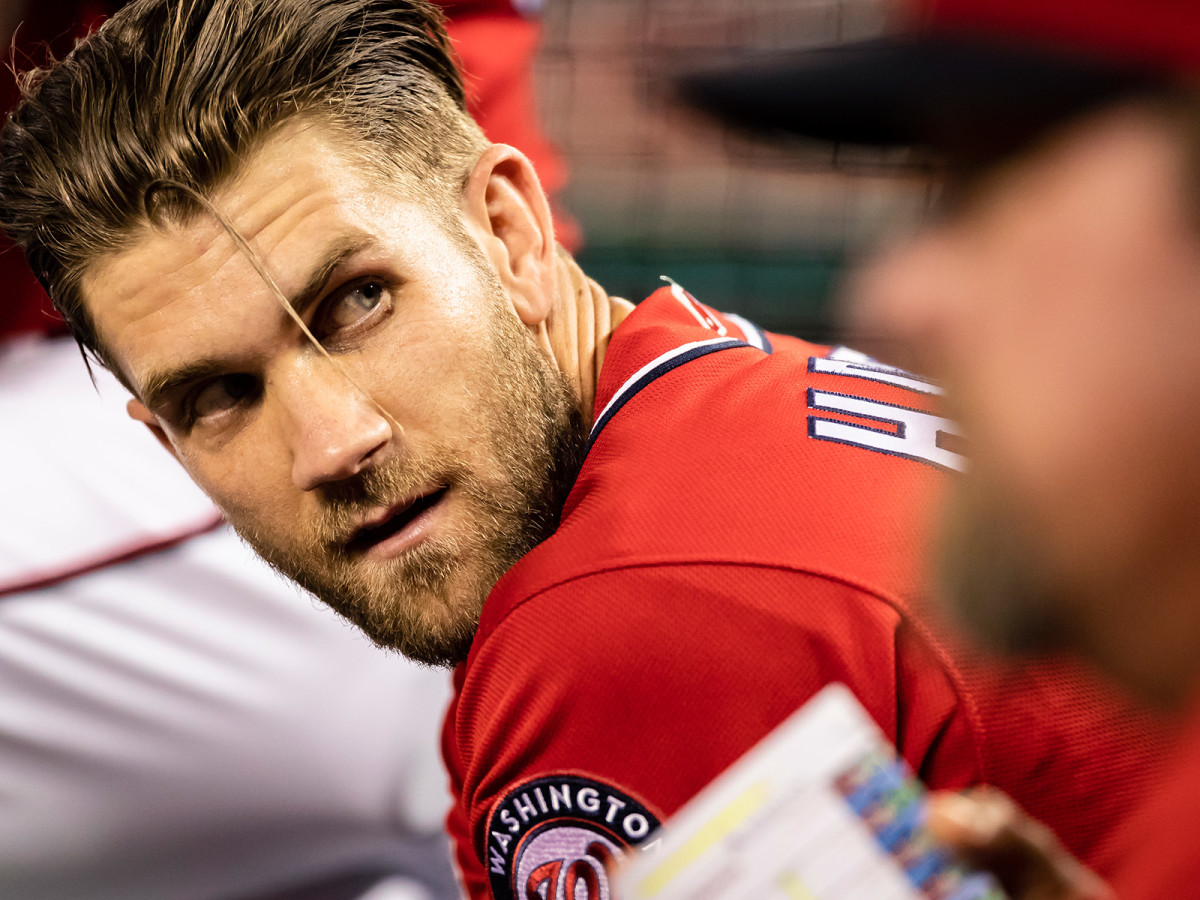
Emma Baccellieri: It’s been less than a week since I wrote that Washington’s situation was getting truly dire. Even I don’t think it’s this dire. They’re still hovering around .500, meaning that they have space to drop before they fall out of the race for either the division or the wild card. Trading Harper would symbolize throwing in not just the towel, but the entire laundry basket—which would require collapsing far more dramatically than they have, plus Harper continuing to break out of his slump to entice the perfect trade partner to make a deal worth it. That’s a lot to ask.
Gabriel Baumgaertner: No. The NL East race is going to be a garbled mess much like the NL West will be, and it’d be foolish to trade a player of Harper’s talent when they still employ Max Scherzer and a recovering Stephen Strasburg. Though they’re a relative disaster at the moment, the Nationals are not far away from returning to the playoff picture, and they have one of the most talented teams in the big leagues. As we saw this weekend, this is a team that can score in bunches even when Harper is struggling. They’re not so far out that they should consider trading him, especially when there is no way to recoup a player of his value.
Michael Beller: Absolutely. We batted around a trade question in this space a few weeks ago, and I stated my belief then that no player should be considered untouchable. On top of that, there’s a very real chance the Nationals will lose Harper this offseason when he hits free agency. If they truly do fall out of the race, they should make him available.
Johnny Bench Is Already a Hall-of-Famer, But He's Looking For a New Distinction
He’ll instantly be one of the top-two players on the trade market, joining Manny Machado. Don’t tell me anything about his batting average, either. Contenders will fall over themselves to add him. And hey, the Nationals could always trade him and then sign him back this offseason. Harper is more likely to lead a second-half surge for the Nationals than the team is to be relegated to spoiler, but the team would be wise to listen to offers if they slide back in the standings over the next few weeks.
Jack Dickey: The age of the high-priced rental player is over. Gone are the days when CC Sabathia or Carlos Beltran would change hands midseason with a passel of prospects coming back in return. (As per usual, the scoundrel Yankees got the best of what was left of this trend, swiping Gleyber Torres and three others from the Cubs for Aroldis Chapman in 2016 before re-signing Chapman after that season.) Teams value the cost certainty of young players too much to trade several of them for someone who could depart in three months.
All of this is to say that the Nationals could not possibly get an acceptable price for Bryce Harper, even if they wanted to trade him. (His underwhelming first half would complicate matters further.) No general manager could justify trading as many as four or five future regulars for two months of a player, and no general manager could accept any less for a player with Harper’s track record and importance to the franchise. Besides, the Nats still have a chance to retain Harper in free agency, one that would diminish were he to be traded. Manny Machado, Harper’s cohort up the Baltimore-Washington Parkway, is in another set of circumstances entirely, since the Orioles cannot possibly expect him to want to stay.
Exiled by the Cubs, Sammy Sosa Is Enjoying the Life He Wants You to See
Connor Grossman: It seems practical that the Nationals should see what kind of return they can reel in for Harper if their playoff chances are decimated by the end of July. It doesn't mean they have to pull the trigger on a deal, but Washington knows Harper better than any other team. If they believe keeping him on the team in a losing season isn't going to give them a leg up in free agent negotiations, why hold onto him? His situation isn't completely identical to Aroldis Chapman in 2016, but I think Washington should look at Harper the same way the Yankees looked at Chapman two years ago: acquire whatever assets you can in a trade and try to re-sign him in the offseason.
Tom Verducci: The idea of trading Bryce Harper this season is absurd. The Nats are not the 2014 last-place Red Sox with reason to move Jon Lester. They are well within range of Philadelphia and Atlanta, two teams on the rise who still have to negotiate a pennant race with expectations, the way Milwaukee needed to last year. The more experienced Cubs ran down the Brewers.
The Nationals are getting back Stephen Strasburg, Ryan Zimmerman and Matt Wieters from injuries and Daniel Murphy needs probably another month to knock off the rust from his knee surgery. There is every reason to believe this team will play much better, and few reasons, other than panic, to think it can’t catch Philadephia and Atlanta.
This is not to suggest Washington is simply going to run off a big second half and leave the Phillies and Braves in the dust. Those teams are legit contenders, and Washington, with a rookie manager and postseason flops, is a team with a culture that can’t be trusted much. But give up the season by trading Harper? It makes no sense.
BEST THING I SAW THIS WEEK: MARK REYNOLDS MAKING THE BEST OF A SLOW OFFSEASON AND HIS MINOR LEAGUE DEAL
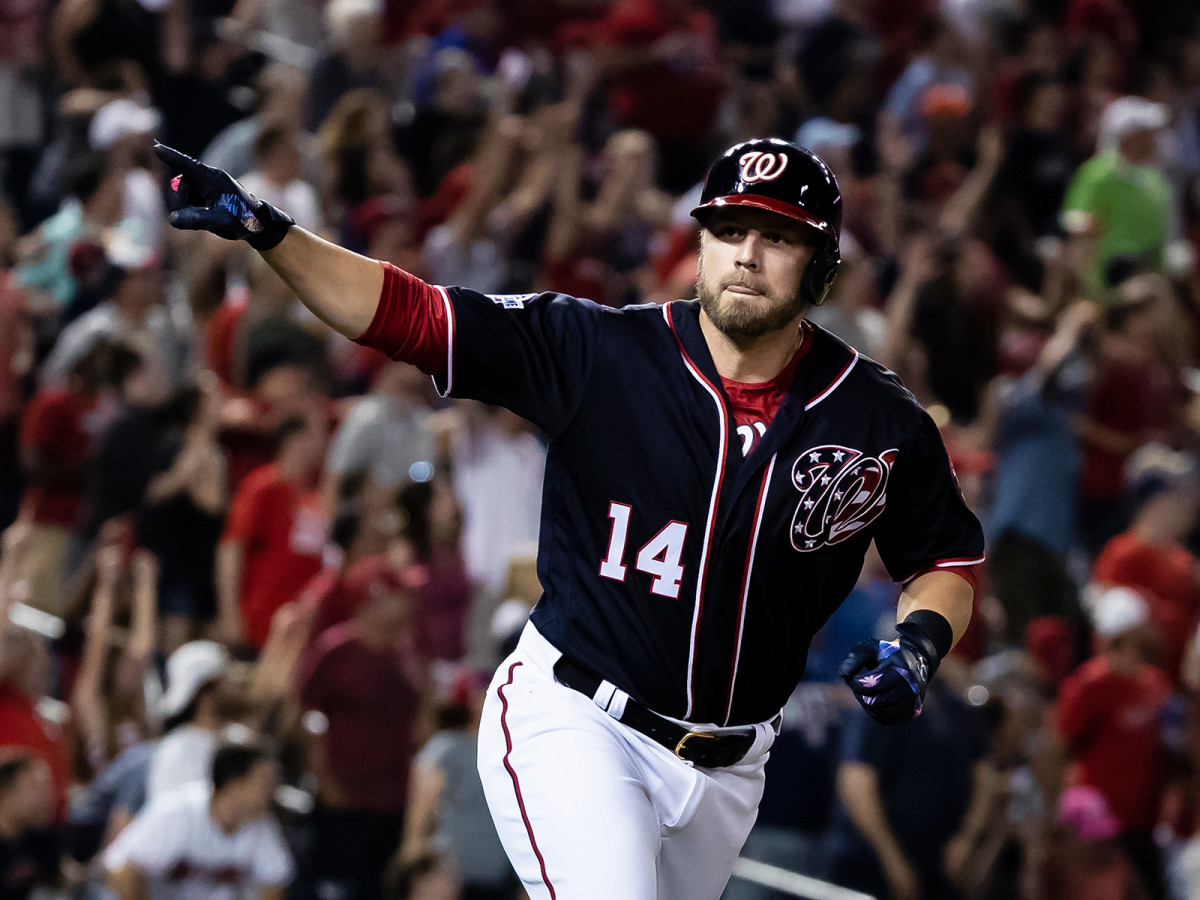
By Jack Dickey
We must marvel at Mark Reynolds’ stubbornness. No club wanted to sign him after his 30-homer 2017, a characteristic Reynolds season in which he finished a win above replacement level while whiffing plenty and costing his team (Colorado) more than a win in the field. January passed, then February, then March—still no contract. Reynolds was turning 35 in July, yes, and his glove troubles had always made him tough to carry as a bench player. But there seemed to be something else at work, too… it was as though the game, having seen offense as a whole turn Reynolds-esque in recent years, decided it wanted nothing further to do with the man himself. This season, for instance, the average first baseman is hitting .250/.333/.438, striking out in 22 percent of plate appearances; for his career, Reynolds has hit .239/.330/.458, striking out in—gulp—31 percent of his plate appearances. Mark Reynolds was hitting like Joey Gallo when Joey Gallo was in junior high!
One funny note is that Reynolds himself has turned less Reynolds at the plate with the passage of time, even as the game has gone the other direction. Over the 2015 to 2017 span, he posted a .262 batting average and struck out in “only” 28 percent of his plate appearances. Among corner infielders and designated hitters with at least 1400 combined PAs over those seasons, Reynolds’ .792 OPS ranked 30th out of 56. (His defensive butchery, though, meant that he ranked 53rd in that same group by WAR, according to Baseball-Reference.)
He landed a minor-league contract with Washington in April, and the Nats sent him to extended spring training and then to the Triple-A Syracuse Chiefs, where he got off to a slow start. But his old University of Virginia teammate, Ryan Zimmerman, hit the DL with back troubles, and Reynolds got the call. He told reporters then: “After last year I didn't envision myself being in extended [spring camp] and Triple-A… Had a lot of offers in the offseason, but they were like, 'Come and try to make our club.' I was having way too much fun golfing and hanging around with my kids than worrying about trying to make a team.”
Reynolds clubbed two moonshots in his first game back, and he did it again eight days later. Soon enough he and Matt Adams had formed a fairly fearsome first-base platoon—since Reynolds’ call-up, Nats’ first basemen have the ninth-highest OPS in baseball, even as the team overall has scuffled.
And then came this weekend. On Friday, with the Nats needing wins against the cellar-dwelling Marlins, Reynolds smacked a pinch-hit, walk-off homer against Kyle Barraclough. Saturday, against Wei-Yin Chen and two Miami relievers, Reynolds posted a five-hit, two-homer, 10-RBI line. Washington won 18-4, and Reynolds became only the 15th player in history to drive in 10 runs in a game. On Sunday, with the Nats going for the four-game sweep, Miami got out to a 3-0 lead. Washington had recovered from a 9-0 deficit on Thursday, but in the series closer no such comeback came. Trailing 6-2 entering the ninth, Washington sent Ryan Madson to the hill, and he got shelled—it was 10-2, with only two out, before Dave Martinez made a pitching change. He summoned, from third base… Mark Reynolds. He retired the only man he faced on a 78-mile-per-hour pitch that Gameday called a curveball.
It’s too late, 1,562 games into his career, for Reynolds to rewrite his reputation as a tin-pan-handed king of the K, and his resurgence this year may very well not be built to last. Still, he deserves praise for this much: He insisted to a disbelieving league that he belonged, and he has proven himself right.
FIVE THINGS WE LEARNED ABOUT THE AMERICAN LEAGUE IN THE FIRST HALF
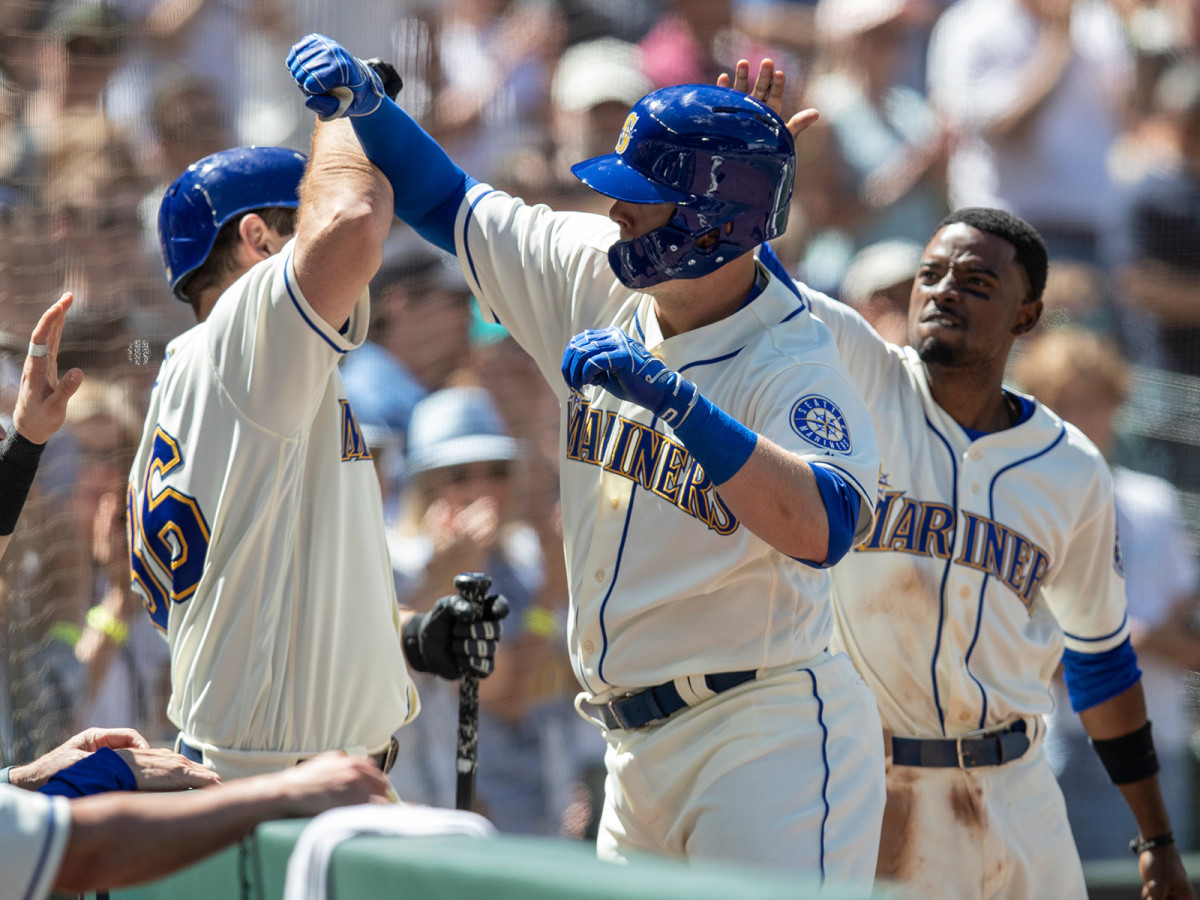
By Emma Baccellieri
1. The Mariners are doing something special here
The Mariners’ unexpected run atop the AL West may have finally come to an end, but they can still boast baseball’s fourth-best record—and a chance to go down as one of the best teams of all time in one-run games. Of Seattle’s 57 wins, 26 have come by a single run, giving them a .703 winning percentage in one-run contests. The mark for them to beat here is the 2016 Rangers’ .766, and this team just might pull it off. They’re lucky, sure, but they’re also good.
2. This Yankees-Red Sox race is one for the ages
Even before the season started, it seemed obvious that these two teams would be well-matched, but it’s still remarkable to see precisely how true that’s been. It’s not just that they’ve been swapping positions atop the AL East. It’s that they’re almost perfect statistical matches for one another. They have the exact same OPS+ (112) and nearly the exact same ERA+ (Yankees: 124, Red Sox: 123). They’re almost tied in slugging (New York’s .462 to Boston’s .461) and pitchers’ walk percentage (New York’s 8.1 to Boston’s 8.0) and home runs allowed (New York’s 1.06 per nine to Boston’s 1.02). The race for first place should be exciting all the way through to October, but the arguments about which team is better just might last forever.
3. Mike Trout is somehow better than ever—but don’t ignore Jose Ramirez and Mookie Betts
We all know about Trout’s ridiculous, awe-inspiring season by now. We should know almost just as much about the incredible performances happening right behind him. By both Baseball-Reference and FanGraphs, there are just two position players within a win and a half of Trout. (That, really, is only another way of saying how incredible Trout has been—less than halfway through the season, there are only two position players within an entire win and a half of him!) Those two are Ramirez and Betts, and each has posted numbers that would have made him the best player in baseball last year after the first half.
If Trevor Bauer Ever Signs a Multi-Year Deal He Will Get Shot in the Groin With a Paintball Gun
4. The AL Cy Young is the best award race in baseball
At the start of the season, Justin Verlander looked like he might be on track for historic greatness. But Luis Severino has dazzled over the past six weeks, and the 24-year-old now boasts a 2.12 ERA to Verlander’s 2.15. Meanwhile, Chris Sale is having the best season of his career, and Corey Kluber is close to matching what he did to win the award last year. The AL’s playoff picture may not be particularly competitive heading into the second half, but the Cy Young race sure will be.
5. Both the Orioles and the Royals have a shot at history
Everyone knew these teams were going to be bad, yes, but not that they were going to be this bad. Since 1900, there have only been twelve teams that have finished with a winning percentage below .280. Right now, Baltimore is at .270 and Kansas City is at .281, and both of these clubs only stand to get worse as they sell at the deadline. It would take some really impressive losing for either to beat the modern record for failure, set by the 1916 Philadelphia Athletics (.235), but it’s not crazy to think that one could beat the 2003 Detroit Tigers (.265) to become the worst team since the 1962 New York Mets.
Oh, and don't forget that just four years ago these teams played in the ALCS.
FIVE THINGS WE LEARNED ABOUT THE NATIONAL LEAGUE IN THE FIRST HALF
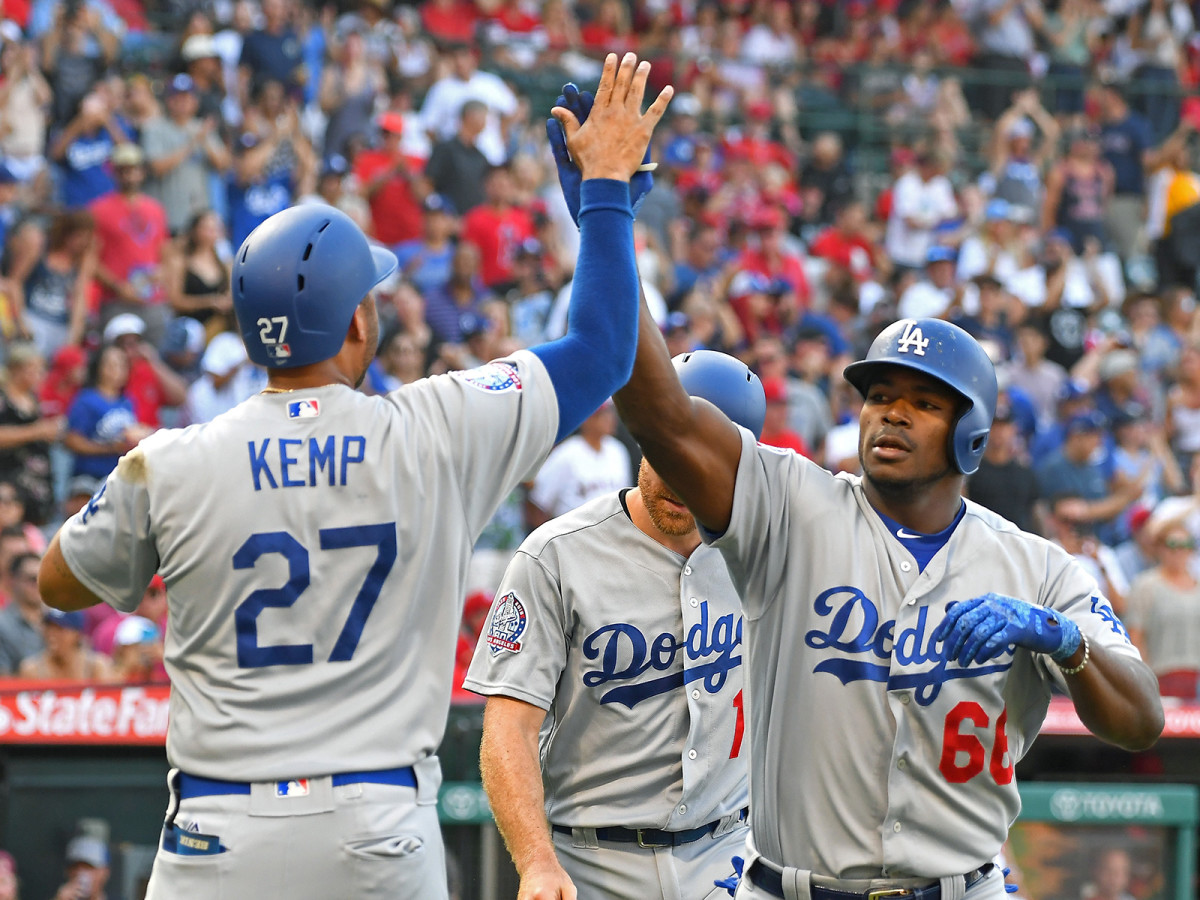
By Gabriel Baumgaertner
1. The National League West has four legitimate contenders for the division.
The NL West race opened once the Dodgers—winners of 104 games in 2017—won 16 of their first 42 games in the 2018 season. The Diamondbacks were the immediate beneficiaries of L.A.’s dreadful start. Despite sinking into a 5–11 stretch in early May, Arizona held an 8.5-game lead over the Dodgers, who had just completed a 1–6 stretch against the lowly Reds and Marlins. Colorado—the team that lost to the Diamondbacks in that NL Wild Card Game—sat just 2.5 games back while the Giants hovered at 22–22.
Now, there are four teams within 4.5 games of the first-place mark in the division, but it’s unclear which of these teams are serious competitors. The Dodgers have turned their season around thanks to the unlikely contributions of Max Muncy and Matt Kemp as well as the healing of a beleaguered pitching staff, and sit one game behind Arizona, which has improved after a dreadful May.
It’s hard to see Colorado, with one of the game’s least trustworthy bullpens and an underwhelming offense, maintaining any kind of momentum as the season reaches its more trying months. And then there is the curious case of the Giants, who play an aesthetically boring brand of baseball and are banking on the contributions of Brandon Belt, rookie starters Dereck Rodriguez and Andrew Suarez, and the resurgent Pablo Sandoval to remain just 3 1/2 games back of Arizona (along with Colorado). This San Francisco team hardly resembles the even-year-magic teams of years past, but a healthy Madison Bumgarner and a steady bullpen should keep them in the race.
I’m still banking on the Dodgers to win the division because of their depth (and that they might have Manny Machado soon), but this is hardly the lopsided race that it was in 2017.
2. The Cardinals are (likely) going to miss the playoffs again
After missing the playoffs just once from 2009-2015, the St. Louis Cardinals are going to miss the playoffs for the third consecutive season barring an substantial stretch of winning or a collapse from the Brewers or Cubs. After a 13-8 loss to the Giants on Saturday, St. Louis sits at 46–43. Outside of the recent play of Marcell Ozuna and Matt Carpenter, virtually nobody on the team is hitting. Their underwhelming play is complemented by the schism between Dexter Fowler and the front office: A report from The Athletic indicated that Fowler and manager Mike Matheny are barely on speaking terms, and GM John Mozeliak questioned Fowler’s effort in an interview while Fowler was on paternity leave. Despite some strong starting pitching from Miles Mikolas and rookie Jack Flaherty, the Cardinals aren’t a serious contender while Milwaukee and Chicago sit atop the NL Central.
Matt Adams is Back from the DL and Ready to Help Fantasy Teams
3. The Padres will be able to charge for their relief pitching
The Padres are having another forgettable year, but they have a desirable crop of young talent that should begin contributing next season. They’re probably going to be active trading partners at this year’s deadline, and they have assets that any competing team seeks: relievers. Brad Hand was one of the hottest names on the market last season, but the Padres kept him after they couldn’t find a suitable package in return. This year, they have four strong relief pitchers in Hand, Kirby Yates, Craig Stammen and Adam Cimber. All four have ERAs under 3.35 and have K/9 rates above 9.5. Yates, Stammen and Cimber have allowed a combined four home runs in 119.2 innings.
The Padres may not look like a force now, but they’ll be able to add to their farm system again and consolidate what should be an exciting young team of the future.
4. The Braves and Phillies are pulling pages from the 2015 Astros and Cubs
It's no secret that the Braves and Phillies have spent the last few seasons preparing to win tomorrow rather than today. Neither team has posted a winning record, let alone fight for a postseason berth, in the last four seasons. With the Nationals' star-studded core, it was expected to be more of the same for Philadelphia and Atlanta. Well, here we are in early July, and that narrative has been completely flipped upside down.
The Braves and Phillies are in a fight for the NL East title while the Nationals are slogging along in third place. Both teams' early arrivals evoke memories of the Astros and Cubs in 2015. Chicago went from 89 losses in 2014 to a playoff berth in '15, while the Astros turned 92 losses into a spot in the AL Wild Card Game. You may also recall both teams have won a World Series title in the past two years. With young, exciting cores of players—especially in Atlanta—we could be looking at the start of prolonged success for these two former powerhouses.
5. Zack Greinke is a cheeky guy
Zack Greinke, nice 69 mph Curveball. 🌈👍♋️
— Rob Friedman (@PitchingNinja) July 8, 2018
Adding yet another game to his consecutive starts with at least one 69 mph curveball streak. pic.twitter.com/22uJQxi1OD
BREAKING DOWN JAVIER BAEZ'S MAGICAL STEAL OF HOME
By Michael Beller
Javier Báez rightfully earned his first trip to the All-Star Game, where he’ll be the starting second baseman for the National League. He wrapped up the best half-season of his career hitting .295/.328/.565 with 17 homers, 63 RBIs and 16 steals. Stat lines, however, don’t tell the full story with Báez. A large part of the reason he’s going to the All-Star Game is because he does things like this.
With all due respect to every other player, there’s exactly one guy who could’ve pulled that off. To celebrate Báez's first career All-Star Game, below are the five best things about the coolest stolen base of the season.
5. The situation. It may have been just the fourth inning, but Báez tied the game by stealing home. The Cubs went on to win the game, 5-2.
4. The jump. There were no outs at the time and Willson Contreras, who will join Báez in the NL’s starting lineup at the All-Star Game, is a dangerous hitter. It wasn’t really the best time for Báez to attempt this play. And yet, he took off immediately when he had the chance. This play cannot work if the runner doesn’t time his jump perfectly. Báez did.
3. The Tigers’ execution. This wasn’t the first time Báez stole home on a pickoff throw to first this season. He did the same thing against the Mets last month. The book is out on him, and the Tigers were ready for it. John Hicks comes and meets the throw from Francisco Liriano, and delivers a strong throw to James McCann. McCann is in the right spot in front of the plate and ready to tag Báez. It’s just that Báez wasn’t there. This wouldn’t have been nearly as cool had Hicks airmailed McCann or if McCann positioned himself poorly. The Tigers nailed the execution on this play. It wasn’t enough.
2. The reaction from Contreras. Look at this. Look how happy he is.
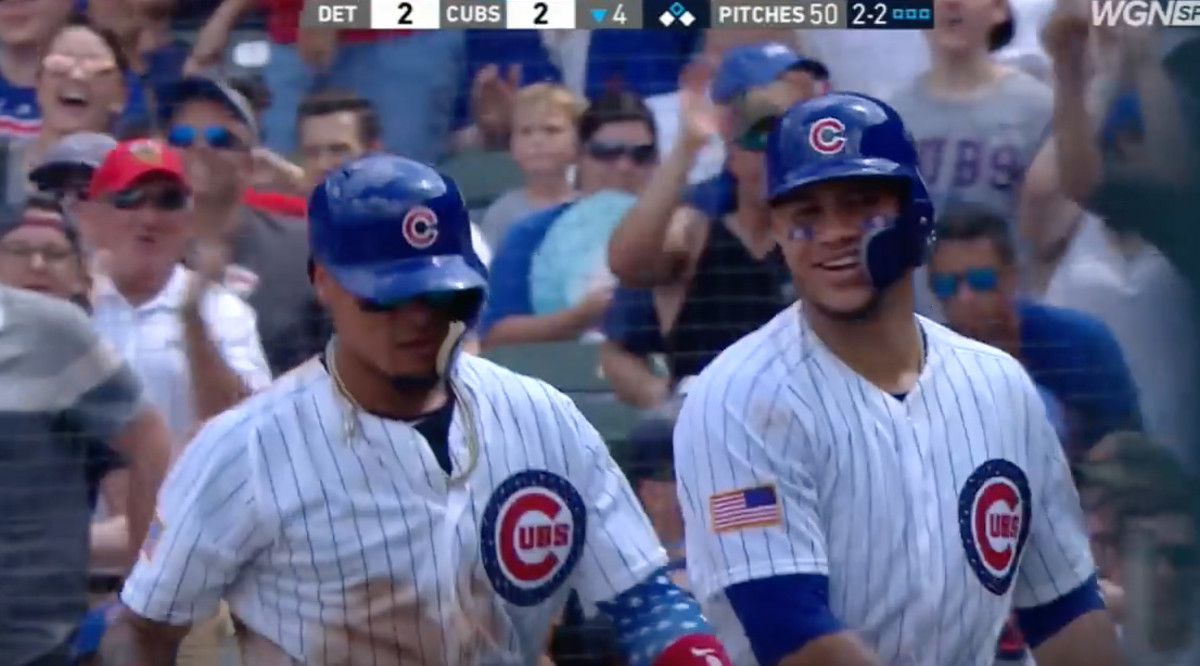
Contreras, too, is a world-class athlete, and he gets to see Báez do his thing every day. And he’s still blown away.
1. The slide. Obviously. That’s a one-of-a-kind slide requiring elite body control. Just think of everything Báez had to do to pull that off. He simultaneously pulls away his left hand, turns his body to keep his chest away from the catcher, and reaches his right hand around to the back of the plate. This picture doesn’t even look real, but it is.
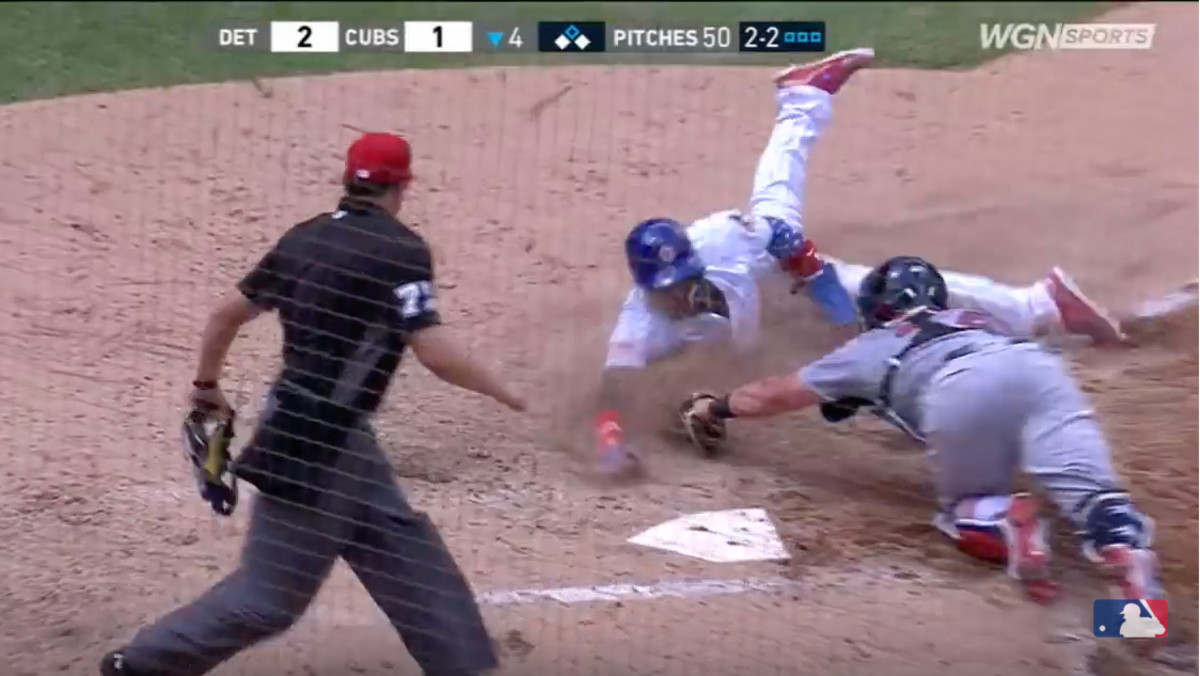
You could spend the rest of your life watching every baseball game possible and not see another slide like that. Báez is magic.
WHAT'S ON TAP: A BATTLE BETWEEN CY YOUNG HOPEFULS HEADLINES THE WEEK AHEAD
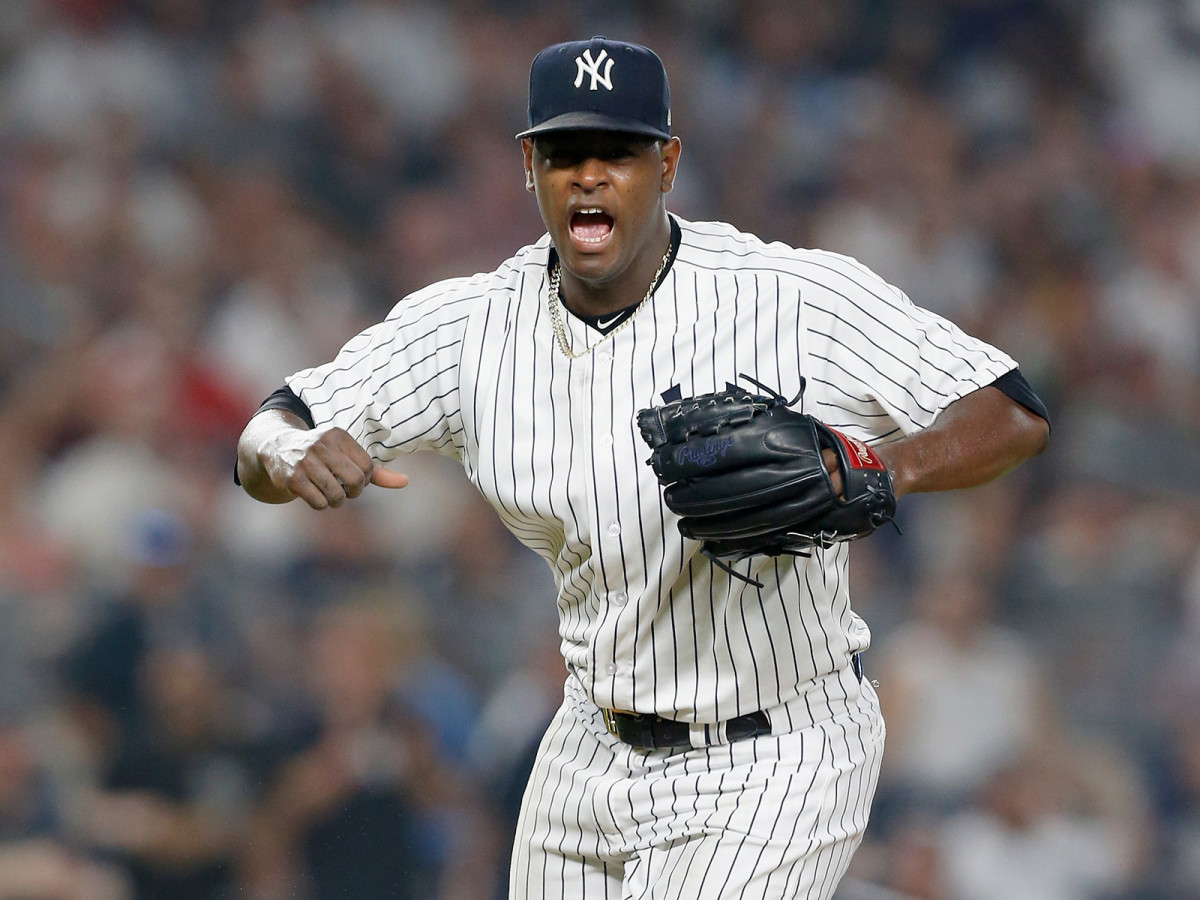
By Michael Beller
Hitter to Watch: Jesus Aguilar, Brewers
Aguilar belted two more homers on Sunday, giving him 22 on the season. Then he got snubbed from the All-Star roster. Thankfully he's a Final Vote candidate. That still seems like a slight to a guy hitting .306/.368/.633 with 63 RBI, helping key the Brewers rise to the top of the NL Central. Aguilar joins Brandon Belt, Matt Carpenter, Max Muncy and Trea Turner as Final Vote options. All five are deserving, but the Nine Innings Week Ahead Committee would vote for Aguilar.
Pitcher to Watch: Chris Sale, Red Sox
Sale kept things rolling this week, allowing one run and striking out 12 in six innings in a win over the Royals. Sale has fanned at least 11 batters in four consecutive starts and hasn’t lost a game in more than a month. He surrendered one run and struck out 10 in eight innings in that game, though, so it wasn’t really his fault. Sale will take the ball once this week, facing the Rangers on Wednesday.
Series to Watch: Yankees at Indians, Thursday through Sunday
The Yankees and Indians enter this week both comfortably in playoff position, and it’s impossible to craft a realistic scenario in which either of the two isn’t playing meaningful baseball in October. This is a great series regardless of the pitching matchups, but we're set for a supreme duel: Corey Kluber and Luis Severino will face off in the opener in a matchup between two Cy Young candidates. After Kluber takes the ball Thursday, the Indians will send Shane Bieber, Mike Clevinger and Trevor Bauer to the mound. The Yankees counter with Domingo German, CC Sabathia and possibly Masahiro Tanaka, if he’s ready to return from the DL.
100 WORDS ON ELIMINATING EVERY TEAM NEEDING AN ALL-STAR
By Max Meyer
It’s puzzling to see the starting pitcher with the AL’s lowest ERA left off an All-Star roster. Ditto for the player tied for the most homers in the NL, who also happens to top the OPS leaderboard. Blake Snell and Jesus Aguilar were snubbed since every team must have an All-Star. Fair or unfair, All-Star appearances are one way to measure greatness, and fan voting already slights worthy small-market players. Having a Pirate or Tiger selected because of the rule takes away additional deserving spots. Salvador Perez and his 68 wRC+, tied for sixth-worst in baseball, in D.C.? Come on.
FROM THE VAULT: REMEMBERING THE LATE GEORGE STEINBRENNER
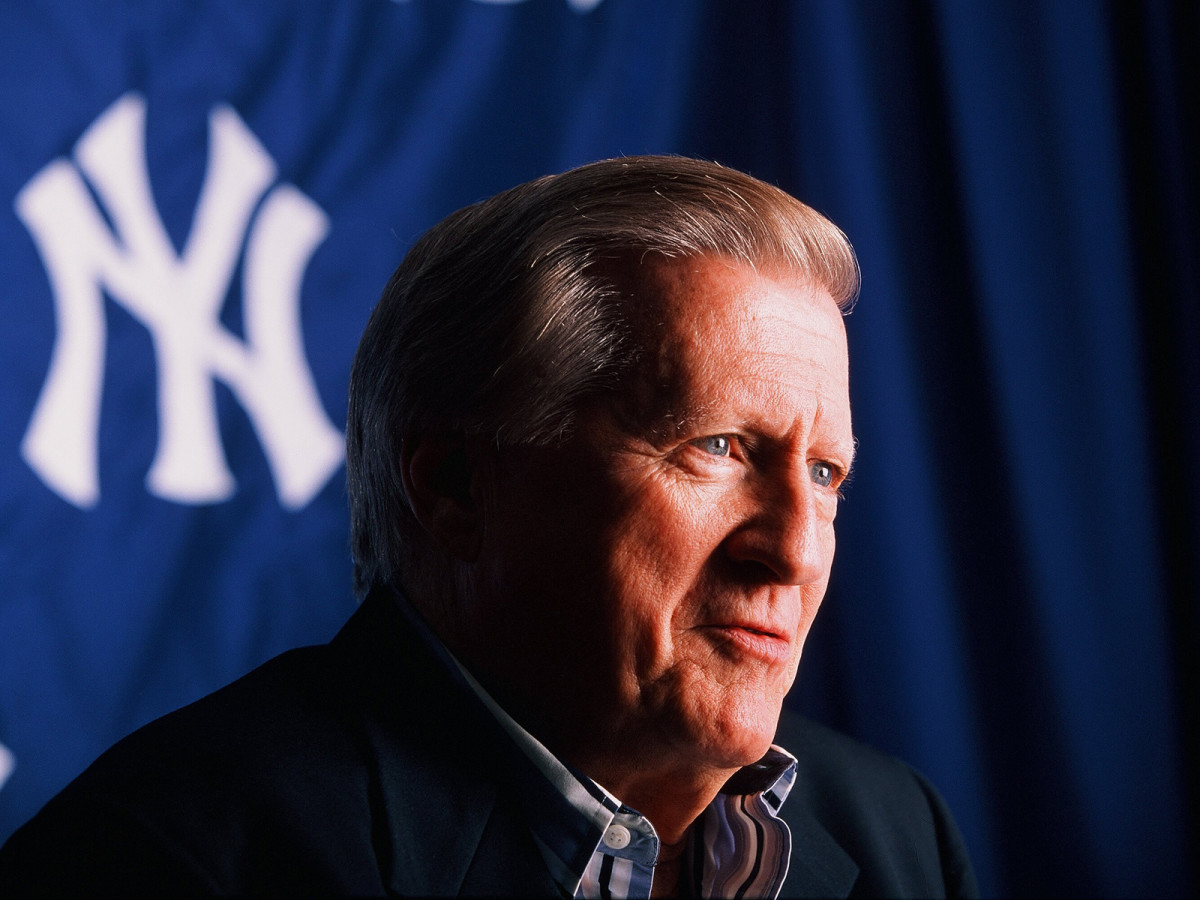
By Connor Grossman
It's impossible to imagine any team owner today getting away with George Steinbrenner's tempermental antics. The hiring, firings, re-hirings, re-firings and inflammatory statements to the media would amount to a social media goldmine. No owner goes about their business quite like The Boss did. The eight-year anniversary of his passing is Friday, so let's revisit his relationship with Billy Martin.
Martin managed the Yankees five times. Five separate hirings. Five separate firings. It is said that Steinbrenner may have elected Martin to a sixth term in 1990 if the Yankees faltered under then-manager Bucky Dent, but Martin died in a car accident on Christmas in 1989. Here's Steve Wulf's account of Steinbrenner's fourth hiring of Martin, which seems to encapsulate the owner's legendary impatience and fly-by-the-seat-of-his-pants nature.
Find the full story here and enjoy the excerpt below.
Steinbrenner had assured Berra that he would be the manager the entire season, but he said the same thing to Lemon in '82. Yogi was lucky to last this long into the year. After the Red Sox blew away the Yankees in the first three games of the season, Steinbrenner talked to Earl Weaver about Weaver's managing the Yankees. Weaver apparently would rather play golf.
The last straw may have come on April 22, when only four Yankees on the roster showed up at the Stadium for a voluntary workout on an off day. Steinbrenner thought the workout should have been mandatory. "I'm damned disappointed in the turnout, especially after a team loses two of three to the Cleveland Indians, who aren't exactly the Detroit Tigers," he said. "But Yogi's running the club, he's the manager so it's fine with me."
